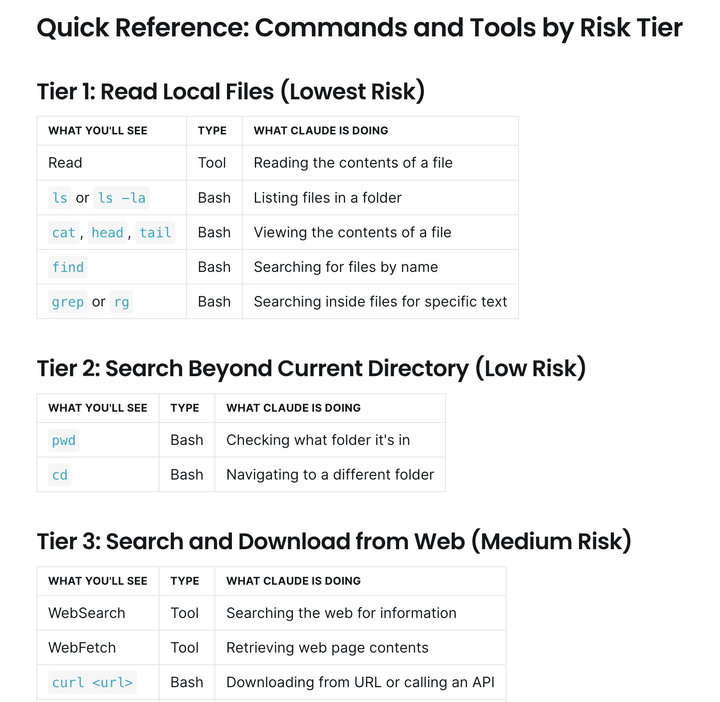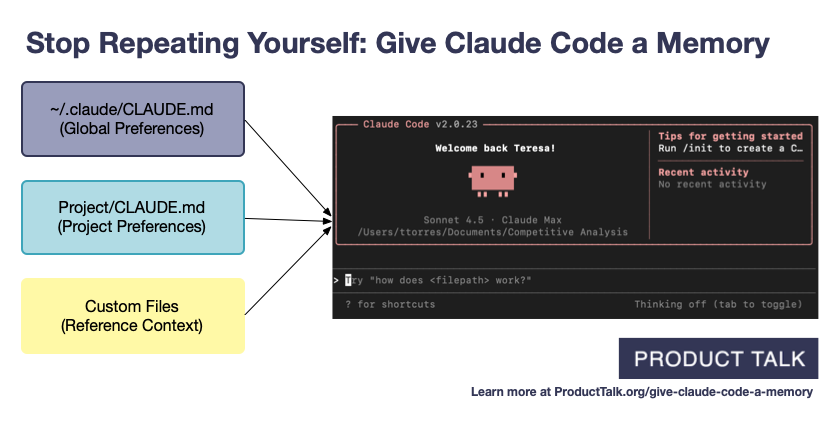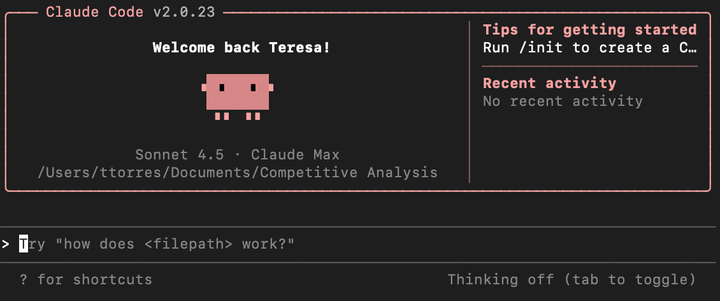21 Ways to Use AI at Work (And Build Your AI Product Toolbox)
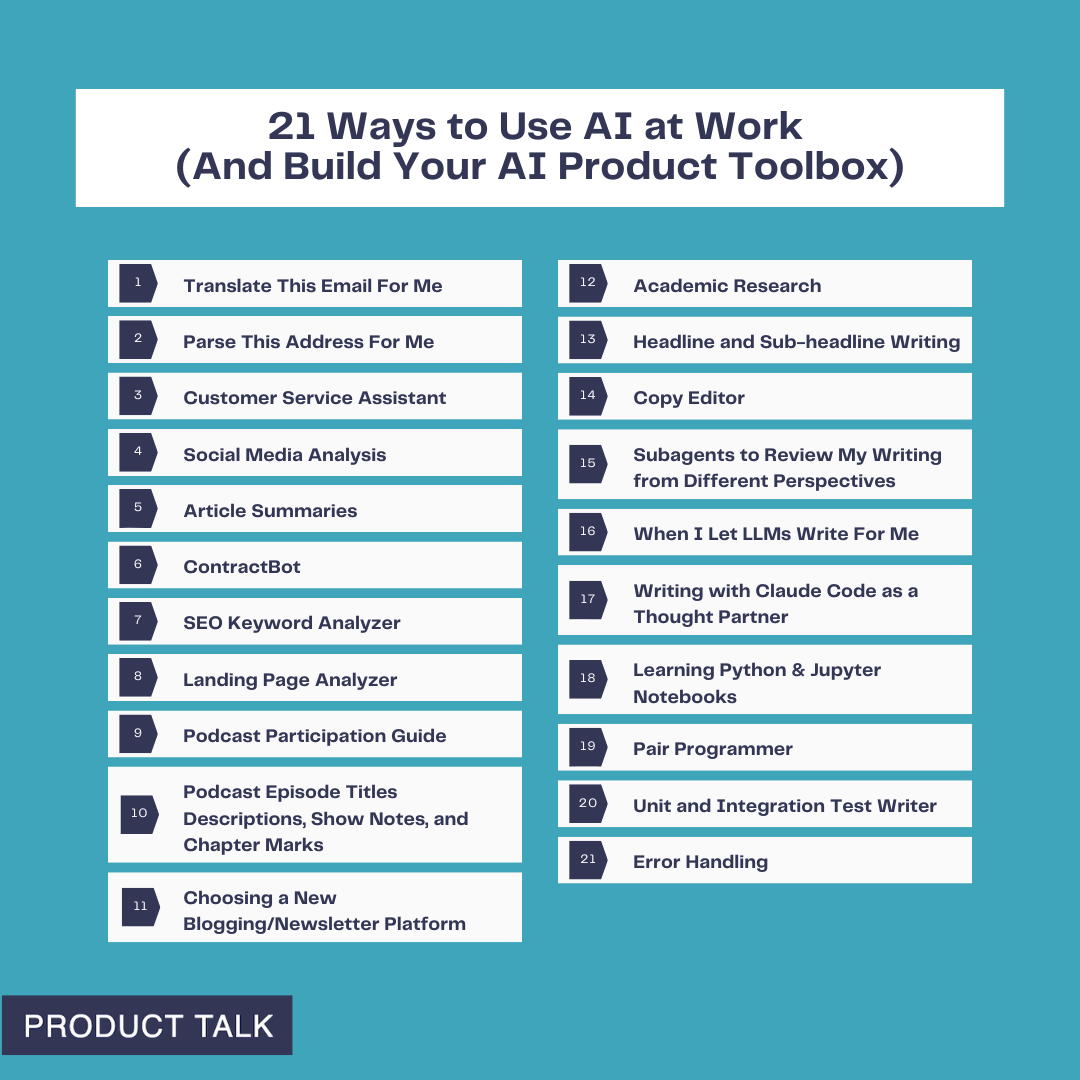
I recently shared 15 ways I'm using AI at home—from fixing cooking disasters to researching school bonds.
Each use case helped me build new AI skills: learning to chat with a large language model (LLM), providing the right context, verifying results, and much more.
Now it's time to look at how we can use these same AI skills at work. This can feel a little scarier. Work can be high stakes. The problems are often more complex. And we have to navigate when and how AI is okay at work and when it's not.
But you'll see the AI skills we've been building at home will provide a strong foundation to help you get started with AI at work.
My goal is to inspire you to start experimenting (if you aren't already). Along the way, you'll also add some new skills to your AI toolbox.
Using AI at home helped us learn the basics—prompting, context windows, and hallucinations. As we explore AI at work, we'll introduce some more advanced skills—think orchestration and automation. But don't worry. Just like last time, we'll take it step by step.
21 Ways to Use Large Language Models at Work (And Build Important Product Skills)
To help you get started, I'm sharing some of the use cases that I use LLMs for at work. They are organized by level of complexity. Start at the top. Once you have a handle on the first one, move to the next. Each use case will help you fill your toolbox.
My work use cases are organized into five buckets:
- Translator
- Do the Work
- Researcher
- Writing Partner
- Coding Partner
Like last time, I'll be reserving some content for our paid subscribers. Everyone will get access to the first three categories, but you'll need to subscribe to unlock the last two sections.
Let's dive in.
Translator
We'll start off easy with a couple of low-stakes examples.
1. Translate This Email For Me
I have a last name that is common in both Spanish and Portuguese. People commonly think that I speak both languages. I can get by in Spanish, but definitely don't know Portuguese.
So when I get an email in another language, I simply ask ChatGPT for a translation. I used to use Google Translate for this. But I find that ChatGPT is a little better about understanding the context.
Okay, I told you we were going to start easy. We didn't even add any complex skills to our toolbox. But don't worry; that's coming.
2. Parse This Address For Me
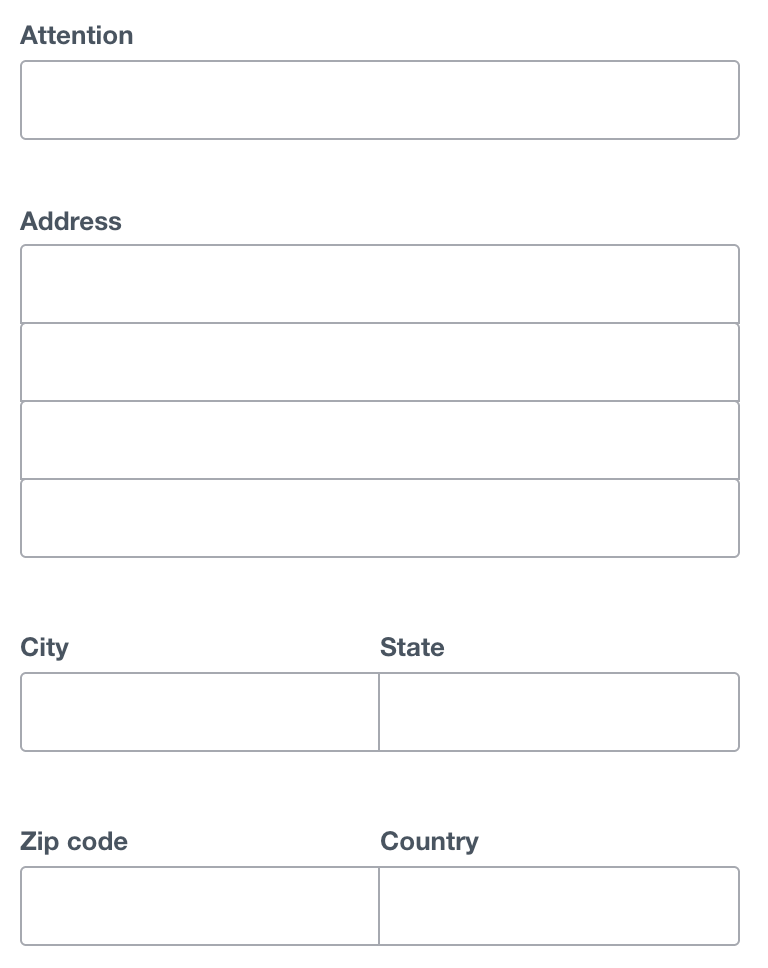
I live in the United States and I work with companies around the world.
I often get asked to add a company address to an invoice. In Xero (my invoicing software), I have to enter the address by street, city, state/region, country, and zip code.
But if the address is from another country, I'm not always sure how to parse the address into those fields.
However, ChatGPT is great at this. I do this often enough that I created a customGPT so that I don't have to write the prompt each time. I just paste in the address and ChatGPT gives it to me parsed by Xero's fields.
If you are new to CustomGPTs, they are simply a way to save prompts and additional context so that you don't have to enter them again and again. You can even share them with colleagues.
Skills you'll learn:
- How to create CustomGPTs for repetitive formatting tasks
- When to use CustomGPTs vs. manual prompts
Do the Work
The real magic happens when AI can do some of your work for you. However, to get real value here, we have to rely on the AI toolbox that we've been building.
3. Customer Service Assistant
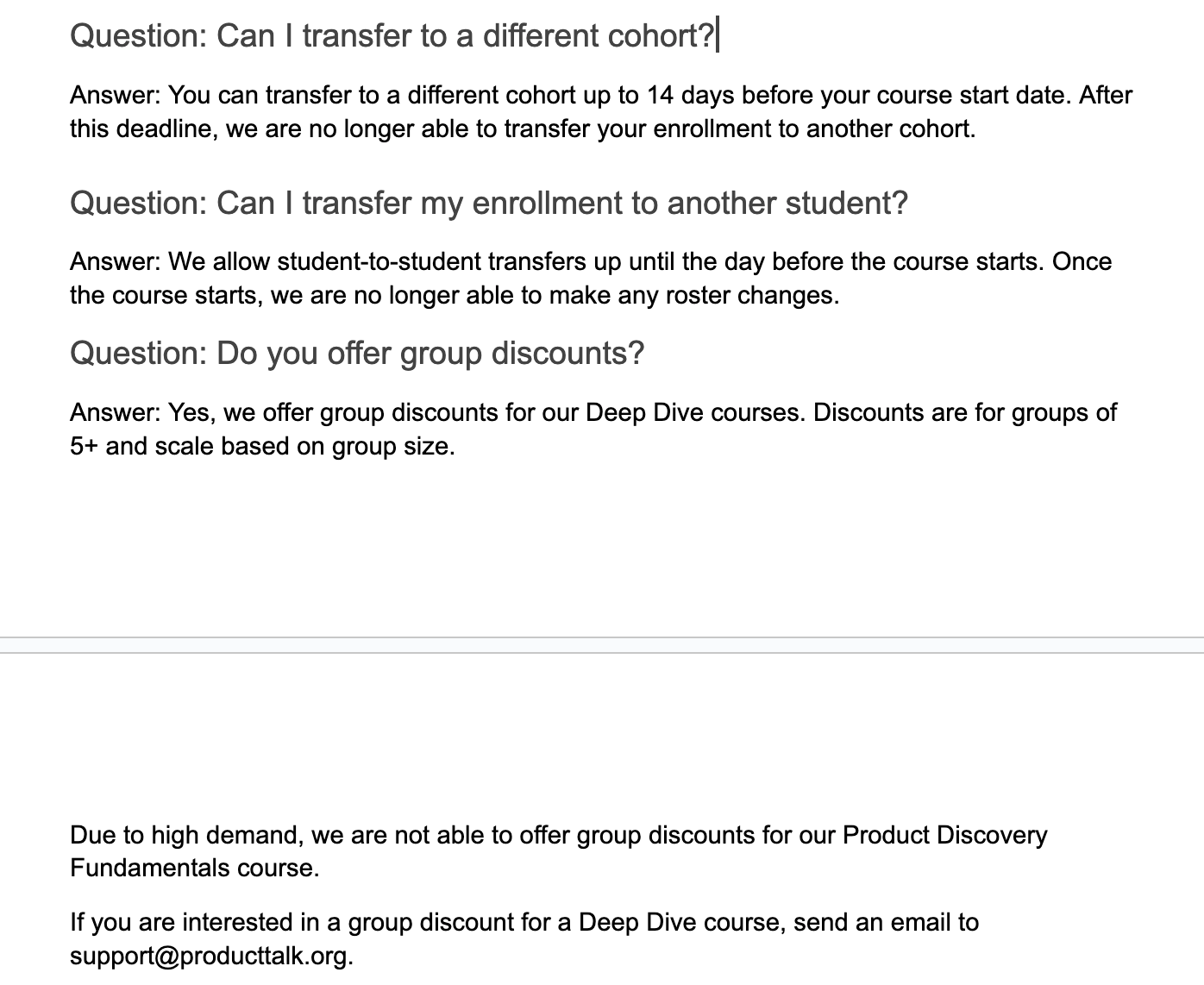
Product Talk offers a lot of different products and services.
To train my admin on customer support, we built a knowledge base with common questions and template responses. However, when responding to a support email, it can be hard to find the right template to use. I wondered if ChatGPT could help.
For this task, I created a CustomGPT. I uploaded our knowledge base content and instructed ChatGPT to select the most relevant templates given a customer support email.
Here's the key: I didn't let ChatGPT draft the email reply. I still want a human in the loop. Instead, ChatGPT is helping my admin find the right templates quickly. She is still responsible for the content of the email.
This is an important distinction. I care about customer service quality and I'm not ready to outsource this to a bot. But we can use ChatGPT to help a human respond faster (and often times even better).
Skills you'll learn:
- When it's important to keep a human in the loop
- How to use LLMs to aid your work so that you can go faster rather than outsourcing your work
4. Social Media Analysis

I use social media to share my work. I want to know what's resonating and what's not. But most social media platforms don't make this easy.
LinkedIn, however, does allow you to export analytics on your top posts. So here's what I do every month:
- I export my top LinkedIn posts for the past 30 days.
- I ask ChatGPT (via another CustomGPT) to create heat maps by topic and category for impressions, engagements, and followers.
- I also graph the trends over time.
This allows me to see what types of posts and what topics are resonating month to month. It also allows me to find clear outliers. For example, my personal stories posts consistently drive the most impressions and engagement, but my short-form video posts consistently drive the most followers.
This is a great way to dive into data—both with analysis and visualization—with the help of a large language model.
I learned this workflow from Andy Crestodina at Orbit Media. I'm a fan of his writing. Check out his work.
Skills you'll learn:
- How to use LLMs for data analysis and visualization
- How to turn raw analytics exports into actionable insights
- How to identify patterns and outliers in your data
5. Article Summaries
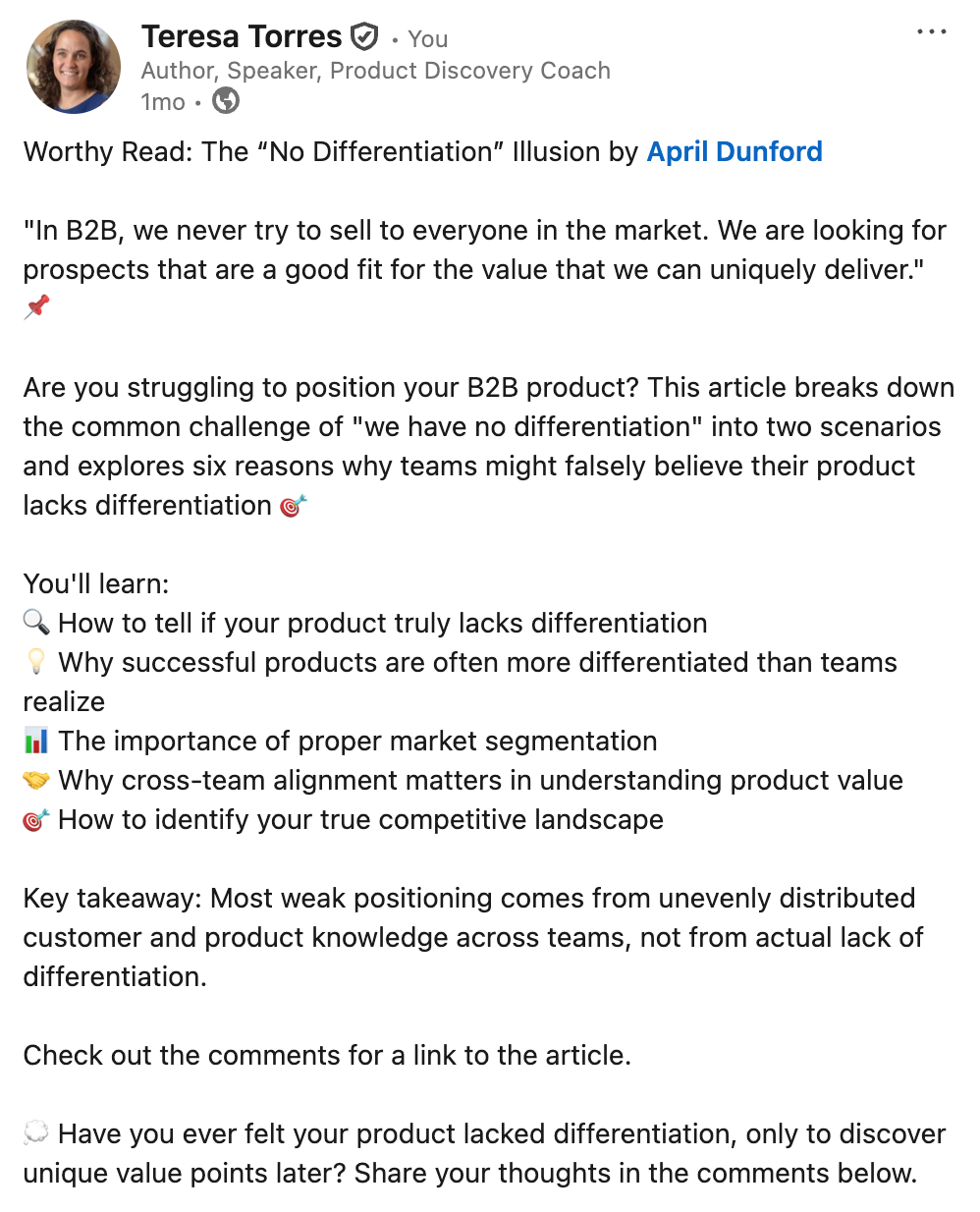
We used to post Worthy Reads—articles that I recommend—on LinkedIn and X every day.
To make these posts more compelling, I started adding detailed summaries of the articles to these posts.
At first, I wrote these myself, but it was very time consuming. So I asked Claude to help. But I didn't want them to sound like an LLM wrote them. I wanted them to sound like the author of the article. So I started crafting my prompt.
I gave Claude guidelines on tone and style. I included writing samples. I defined the structure of each summary. The more guidance I gave, the better each summary got.
To start, I was manually generating these summaries in the Claude web interface. It was time consuming. So I decided to try to automate it.
I created a zap (from Zapier) that triggered whenever I added a new article to my Worthy Reads database. It then used the Anthropic API to generate the summary.
However, I wanted to keep a human (me) in the loop. If I was going to post these on my personal social media accounts, I wanted to make sure they sounded reasonable. So I also added an action to the zap to email me the new summary.
If the summary looks good, I don't have to do anything. If I need to make some tweaks, it’s just a click away. This saves me a ton of time.
Skills you'll learn:
- How to give the LLM the right context so that it writes with the right tone and style
- How to create your first simple automation
- How to keep the human in the loop for final review without adding too much work
6. ContractBot
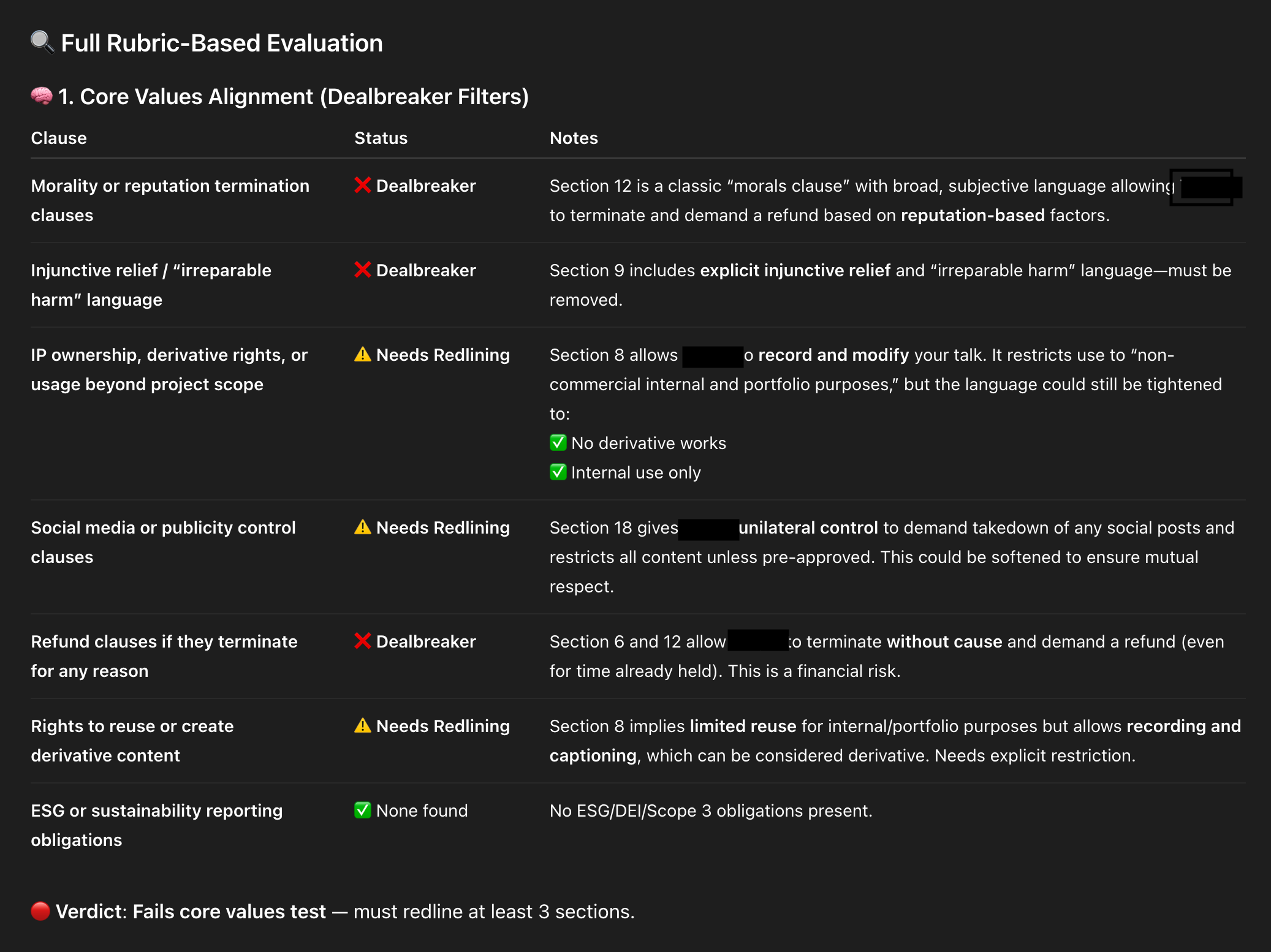
I regularly have to review long legal documents when I'm contracting with a new company. And I absolutely hate it.
So naturally I created ContractBot (yet another ChatGPT customGPT) to help me.
It all started when I got a particularly one-sided contract that favored the company and put many of my rights (e.g. intellectual property rights, morality clauses, payment terms) at risk based on the whim of the company.
I knew right away I wasn't going to work with the company, but I decided to check my gut and I asked ChatGPT for feedback on the contract.
ChatGPT agreed with me. The contract had many issues. We worked through them one at a time.
When we were done, I asked ChatGPT to summarize what we flagged. I reviewed the list, added a few things that I had seen in other contracts, and then I asked ChatGPT to create a prompt that I could use in a new customGPT (ContractBot) that could help me review contracts in the future.
Side note: Asking ChatGPT to write the prompts that you'll use over and over again is a great way to get consistent high-quality output from an LLM.
Now whenever I get a new contract, I upload it to ContractBot. It provides a summary of necessary redlines based on my personal red flags.
When I encounter any new problems, I ask ChatGPT to update my CustomGPT prompt. My ContractBot gets even more personalized to my preferences over time.
I can't tell you how many hours I save using ContractBot. It explains legalese to me. It helps me draft redlines. It helps me understand how terms tend to vary by company size and industry. It helps level the playing field. I can now negotiate contract terms with companies who have a team of attorneys.
Skills you'll learn:
- How to iterate on your preferences over time with an LLM
- How to use an LLM to review, understand, and revise long, hard-to-read documents
- How to use LLMs to balance information asymmetry
7. SEO Keyword Analyzer
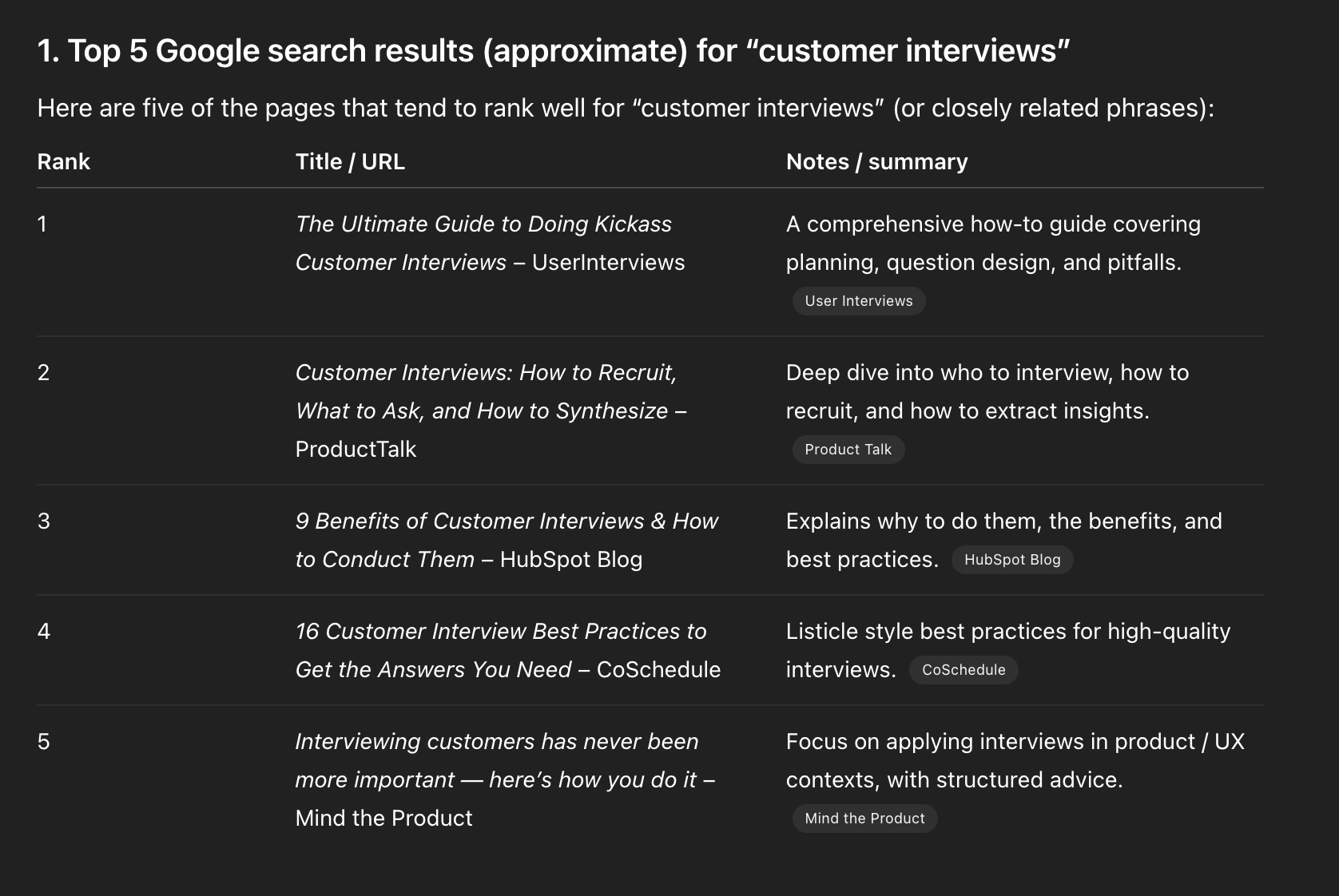
SEO is dead. People don't use search engines. Now they just ask LLMs.
But here's the thing: LLMs still use search engines. Which means SEO is not dead.
So I still care about ranking for my most relevant search terms. And I love asking ChatGPT for help.
Here's how I do it:
- I give ChatGPT a target keyword.
- I also give it one of my articles.
- And then I ask it to analyze the top ten Google results for that keyword and to provide a summary of what those articles do to rank well for that keyword that my article doesn't do.
ChatGPT then gives me a detailed report of how I can improve my article.
Now I don't always take ChatGPT's advice. I'm primarily writing for humans. But, oftentimes, a change that improves the SEO of an article also improves the readability for a human. Those changes are a win-win.
This is work I never would have done without the help of an LLM. Seriously, I just didn't care enough about SEO. But now it's effortless.
This is another workflow I learned from Andy Crestodina. Seriously, go read his blog.
Skills you'll learn:
- How to use LLMs for competitive research and gap analysis
- How to balance SEO optimization with human readability
- How to create repeatable research workflows
8. Landing Page Analyzer
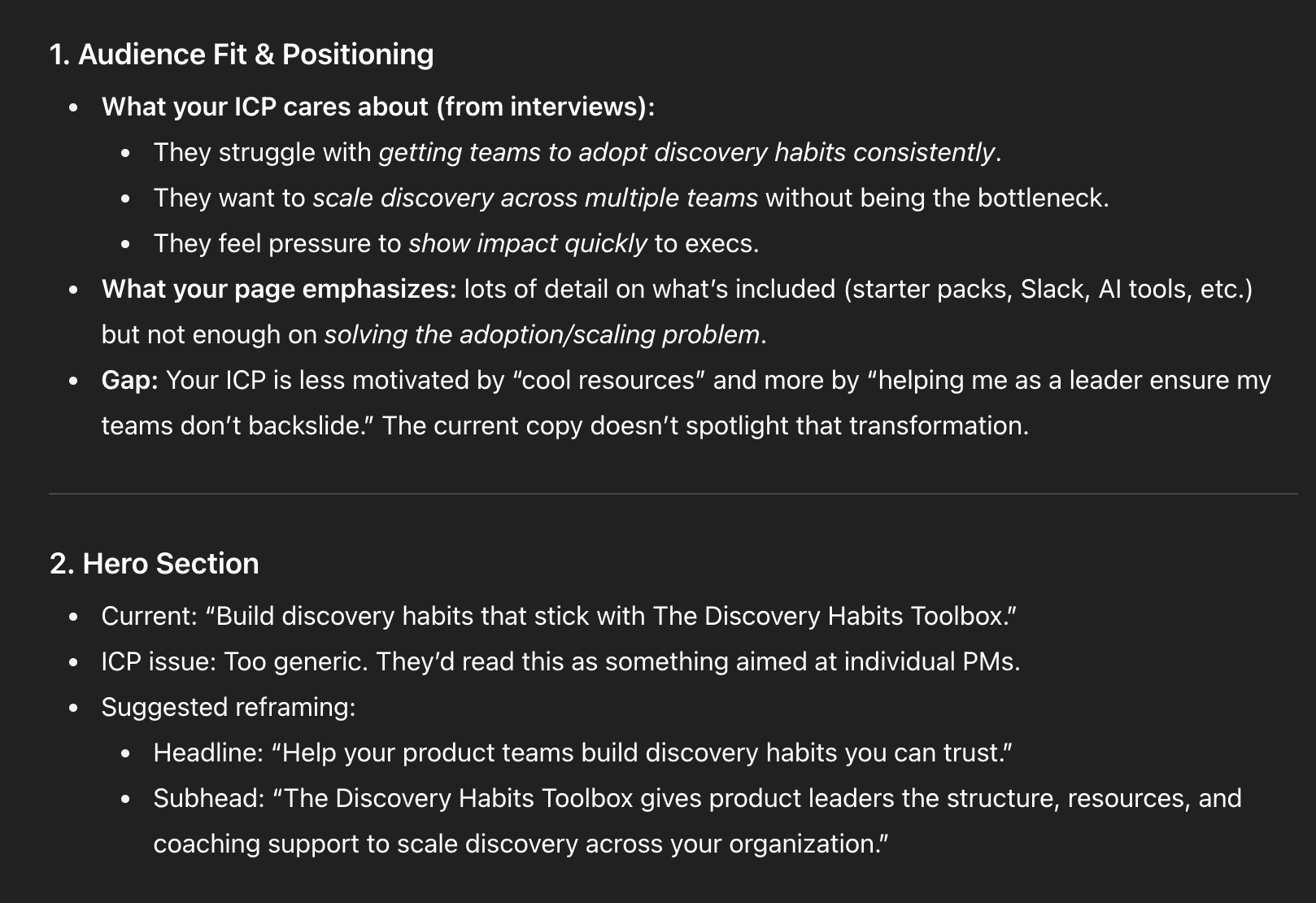
I hate writing sales copy.
In my dream world, I get to just create things and people magically find them and buy them.
But I know that dream world doesn't exist. Landing pages matter. A lot.
So I took another tool out of Andy Crestodina's AI toolbox and I started using ChatGPT to analyze my course landing pages.
But I didn't just give ChatGPT a URL and let it run wild.
First, I was deliberate about the context. I gave it a rich ideal customer profile—the kind I created from real discovery interviews. I gave it a course syllabus, a set of student testimonials, and the same knowledge base document my CustomerServiceBot works from.
Then with all that context, I asked ChatGPT to critique my landing page from my buyer's point of view.
Context is king here. The more context you can give it, the better recommendations you'll get.
Just like with the SEO keyword analyzer, I don't always follow all of ChatGPT's suggestions. I still use my own judgment. But it can be really helpful to get a second pair of (virtual) eyes on my landing pages. It helps me get out of my own head while doing a task that I generally dislike.
I'll also share that I also run discovery sessions on all my landing pages. This is an additive step. It doesn't replace the demand testing and usability testing that I already do.
Skills you'll learn:
- How to use LLMs to guide you through a task you want to procrastinate on
- How to give an LLM the right context to do good work
- How to get "expert" feedback from an LLM
9. Podcast Participation Guide
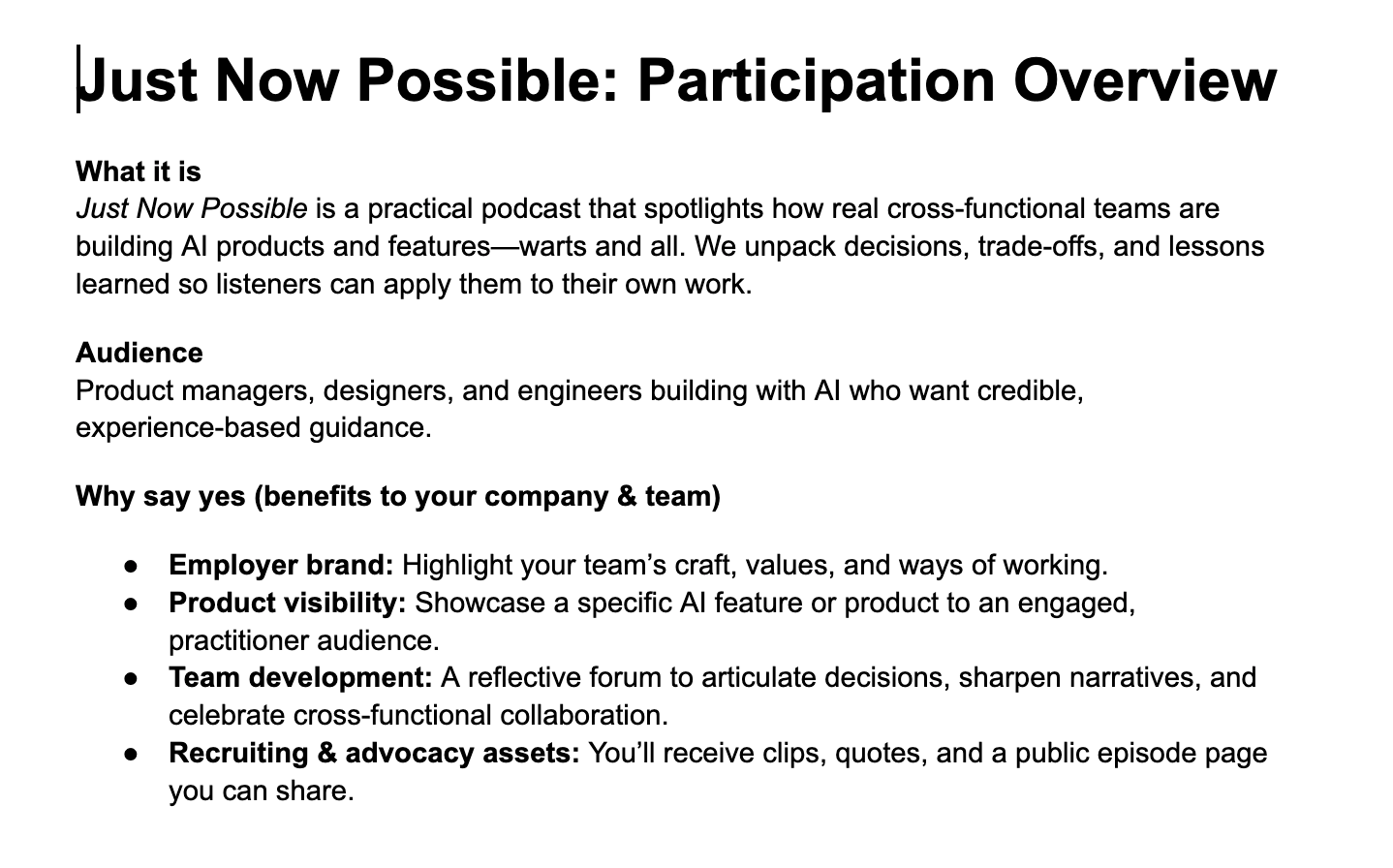
I recently started a new podcast, Just Now Possible, where I interview product teams about the AI products and features they are building.
It can be a little tricky because teams have to get permission from their companies before they can participate.
I've been on hundreds of podcasts. But I've never had to ask permission to participate in one.
So when I was asked to put together a document that people could share with their executives to get sign-off, I had no idea what to put in it.
But here's the thing. I had already created a Just Now Possible Project in ChatGPT with some background files. It has a target listener file, it has context about my goals for the podcast, and how I hope to differentiate from some of the other big AI podcasts.
So all I had to do was start a new chat inside that project. I simply asked ChatGPT to draft a one-pager explaining to an executive why their team should participate. ChatGPT nailed it. See for yourself.
The reason why this worked is because ChatGPT already had all of the context it needed to help. This is why I like Projects and CustomGPTs. You set them up once. You can add to them over time. But it's like having a pre-loaded workspace where the LLM already has all the context it needs to help you with your work.
Skills you'll learn:
- How to set up Projects for ongoing work domains
- How to accumulate context over time for better AI assistance
10. Podcast Episode Titles Descriptions, Show Notes, and Chapter Marks
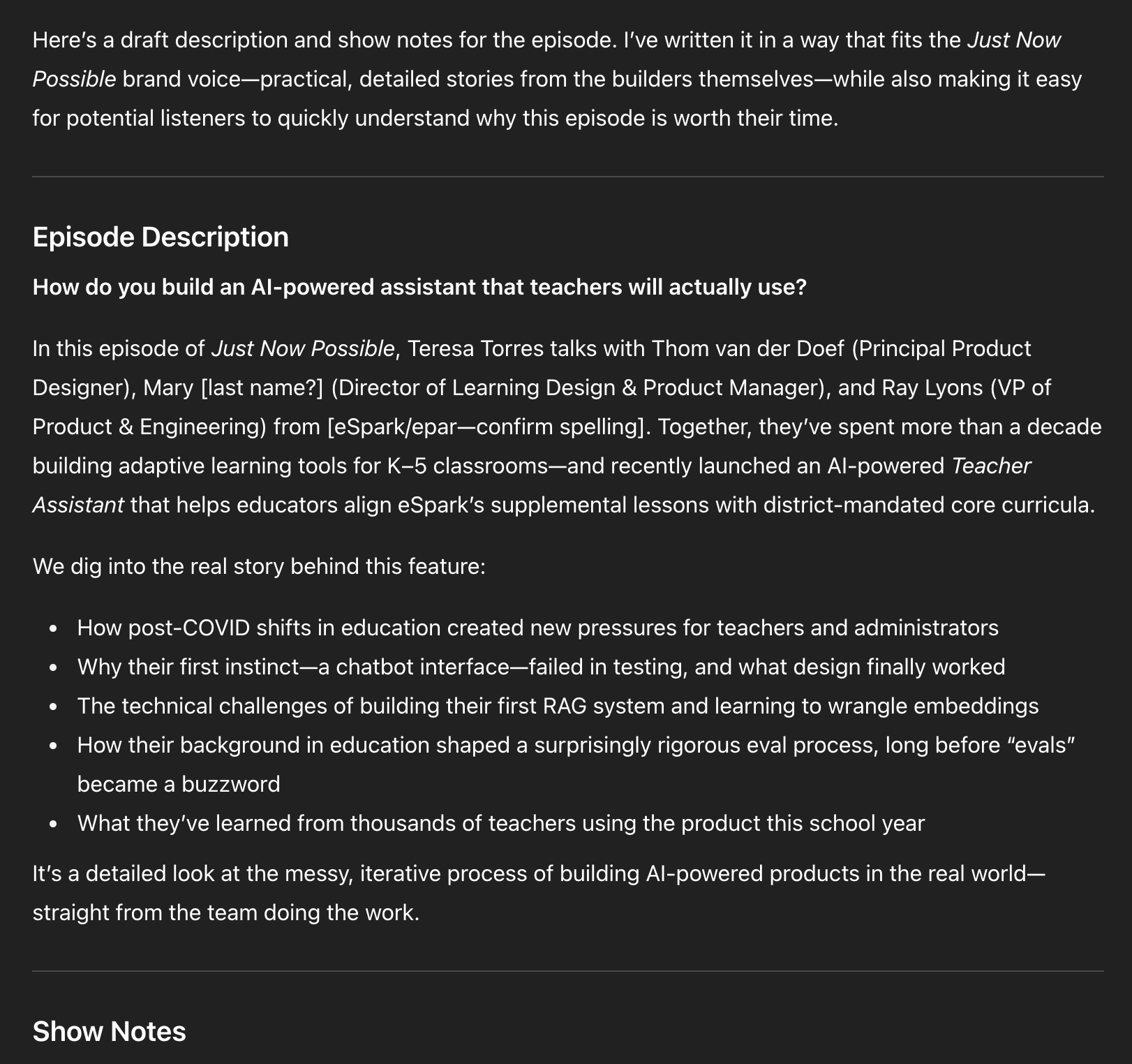
I use the exact same ChatGPT Project to generate episode titles, descriptions, show notes, and chapter marks.
I copy and paste the full episode transcript into a new chat in the Project and ask it to generate each of these elements for me.
As I write this, I'm realizing a key difference between a Project and a CustomGPT. And this use case is ready to be transitioned to a CustomGPT.
Here's why: Right now, I have to ask ChatGPT to generate each of these elements for every episode. I'm only on episode two, which is why I'm just now realizing this. But by the time I get to episode ten (or even five), this is going to get old fast.
Instead, if I move all of the Project files to a CustomGPT, I can add custom instructions and tie it to an action. That's something we haven't discussed yet.
When you define a CustomGPT, you can define different actions and then provide instructions (e.g. a prompt) for each action. So for my Just Now Possible CustomGPT (which I am going to create as soon as I finish writing this article), I'll define an action for generating episode metadata. Instead of retyping my prompt, I'll just click a button and paste in an episode transcript.
Later, I can add another action to generate social media posts for each episode. And with time, I'll keep adding more actions to support all of my Just Now Possible tasks.
I don't need to know all the things I need it to do upfront. I can just keep adding to it with time.
Skills you'll learn:
- The value of CustomGPTs over Projects
- How to use CustomGPT actions
- How to evolve your LLM tools over time
Researcher
If you read my AI at Home article, you've already been introduced to using LLMs as an expert researcher. But I love this use case even more at work. I'll share two of my recent use cases.
11. Choosing a New Blogging/Newsletter Platform
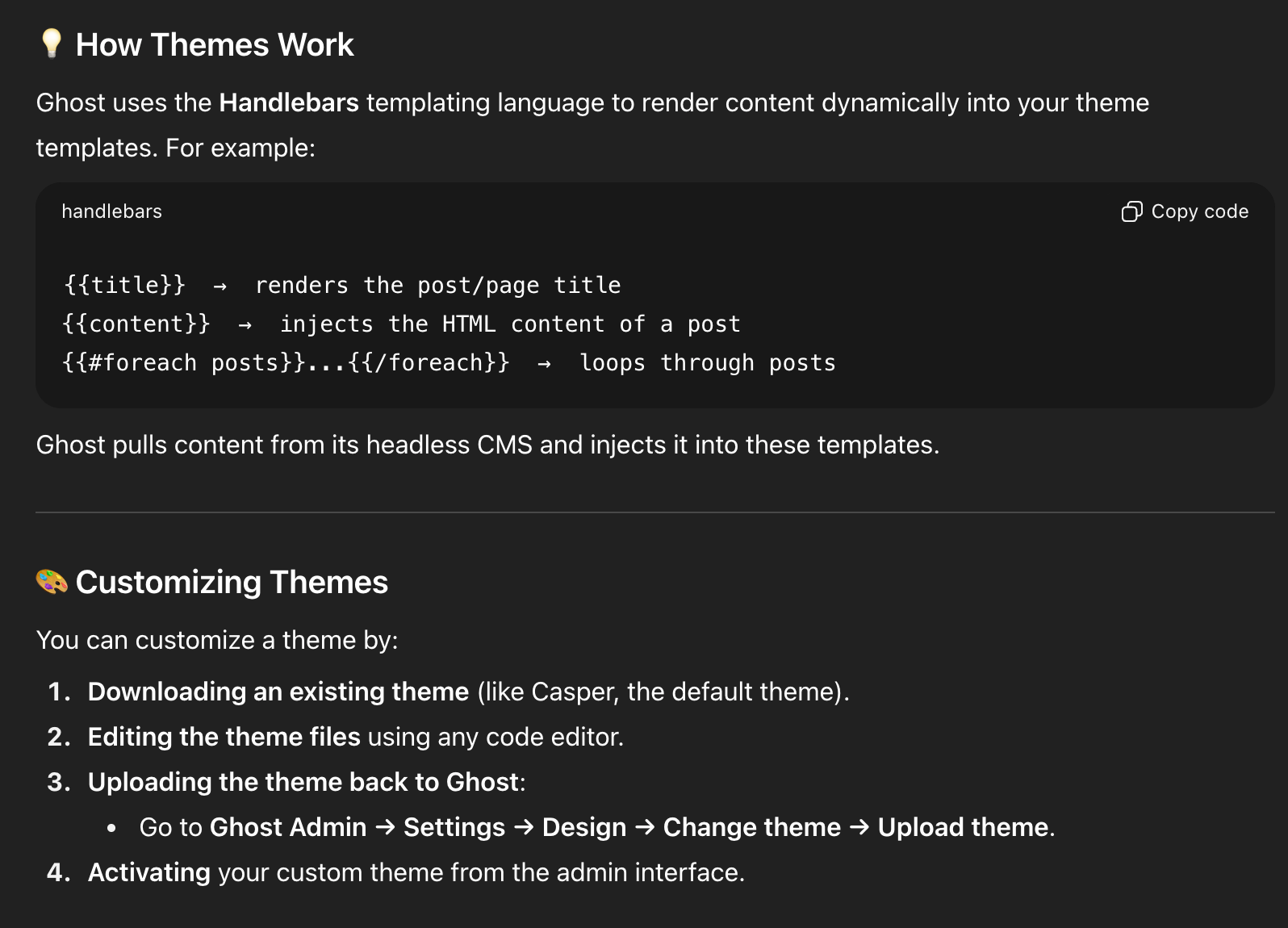
I've been on WordPress for 14 years.
About a year ago, I started to have problems with my site. My events plug-in would auto-update and create critical errors on my site. Google was dinging me for 500 errors and a slow site. I hated managing plug-ins.
It was definitely time to find a better solution. But it felt daunting.
A year ago, I switched from Mailchimp to Kit (formerly ConvertKit), but Kit never really lived up to the hype for me. Could I kill two birds with one stone and replace both WordPress and Kit?
I considered moving to Substack. After all, that's what everyone else is doing. But I have mixed feelings about Substack.
I put all of that into ChatGPT and asked it what it thought. We went back and forth on the pros and cons of different platforms.
I eventually landed on Ghost.
But would I regret it? It's a lot of work to migrate a site and a mailing list. Before I made a final decision, I used ChatGPT to help me deeply evaluate the fit.
We talked through what it would take to customize a theme and how I could manage memberships. We reviewed and evaluated the API documentation together. I signed up for a free trial and ChatGPT walked me through how to export my WordPress data and import it into Ghost.
There were some things that I wanted to change that weren't possible without customizing a theme. Claude Code helped me with that as well.
By the time my two-week trial was up, I had imported my data, customized my site, learned how to use Ghost, and evaluated if it was a good fit for me—all with the help of ChatGPT.
Product Talk officially migrated from WordPress to Ghost in August 2025.
None of this is rocket science. But I can't express how much confidence I have when tackling daunting projects because I know that I have a guide I can turn to whenever I need it. That's invaluable.
Skills you'll learn:
- How to take on big projects knowing that you'll always have help when you need it
- How to use AI for complex vendor evaluation and comparison
- How to test and validate major technology decisions with AI guidance
12. Academic Research
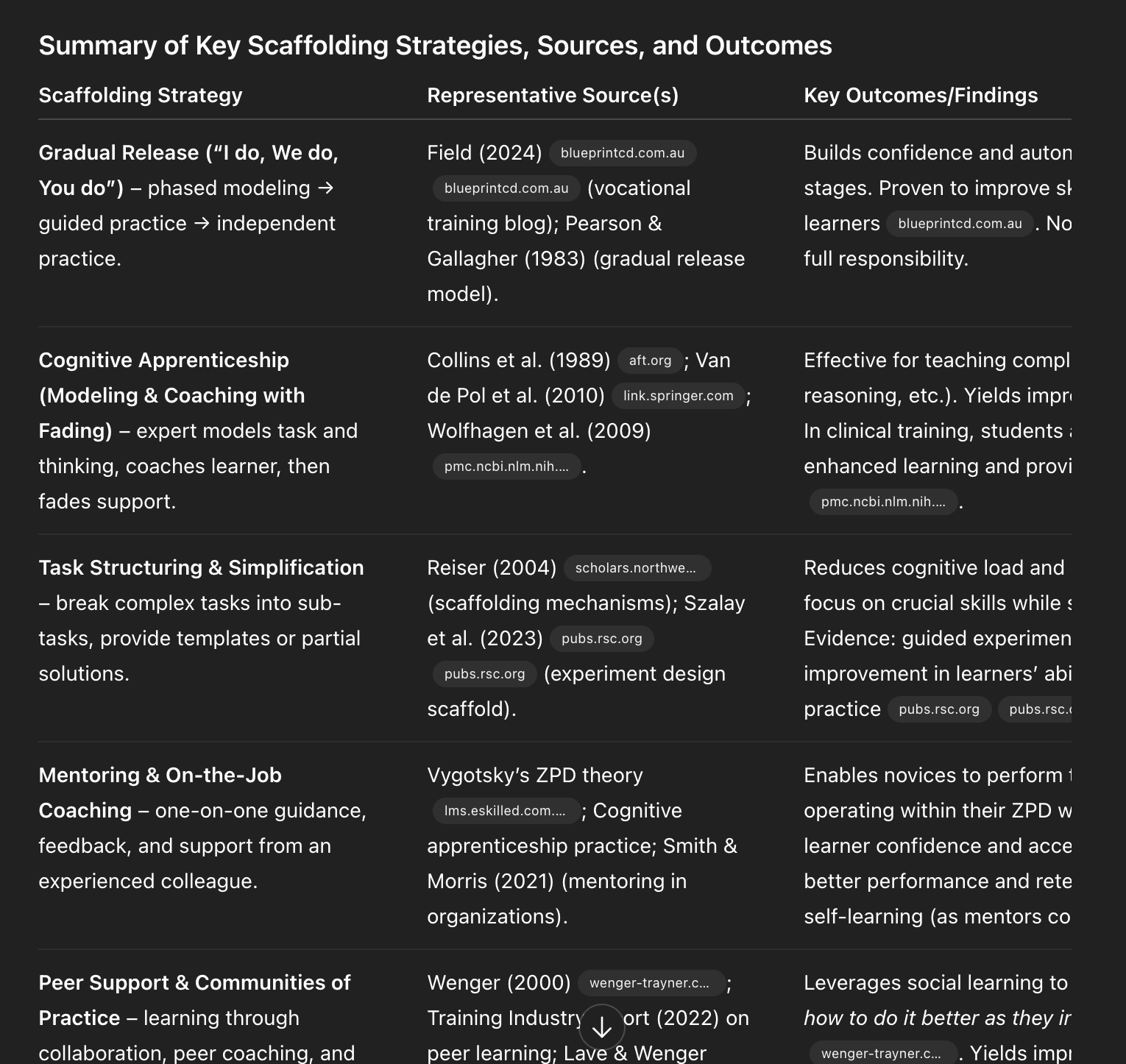
If you've read Continuous Discovery Habits, then you already know that I like to draw inspiration from the academic literature on decision-making, problem-solving, and critical thinking. I also like to keep up on the current research on teaching and learning.
But this isn't easy to do. I'm not an academic. I can't spend hours a day browsing and reading journals.
That changed when ChatGPT's Deep Research came out. Now I run quarterly reports on each of these topics.
For example, I might ask ChatGPT: Can you generate a Deep Research report on the latest research (since June 2025) on decision-making? Limit your resources to well-respected, peer-reviewed articles. If a pre-print paper seems particularly relevant, include it, but note explicitly that it is a pre-print paper. In your report, provide a high-level summary of any of the new finding and then provide a synopsis for each article. Be sure to include full citations at the end.
I used to manually run these each quarter. But I've recently automated it. So now this task is on autopilot. The reports show up in my Readwise inbox and I review them like any other new blog post or article. It's an easy way to stay current on the research that matters most for me.
And here's a bonus tip: I have a course design Project in ChatGPT. I seeded that project with Deep Research report on educational topics like scaffolding, modeling, learning styles, etc. So now when I ask ChatGPT for course design help, I get evidence-based support. I love this.
Skills you'll learn:
- How to conduct Deep Research on any topic you care about
- How to automate this workflow so that it becomes effortless instead of a nice-to-have that you never get to
Learning How to Use AI as a Thought Partner
By far the most value I've gotten out of working with LLMs is by learning how to use them as a thought partner.
It's hard to explain what I mean by this, so instead, I'll try to show you with detailed examples.
First, I'll share how I write with AI. We'll start with some simple examples—headline writing and copy editing. But we'll quickly get into some more complex examples. I'll share:
- How I've set up different subagents to review my writing from different perspectives.
- When I let LLMs write for me and when I choose to write for myself.
- Why I now do all of my writing in VS Code with Claude Code following along every step of the way.
Collectively, these workflows have helped me to write more, higher-quality content quicker. They've also helped me rediscover the joy in writing.
Next, I'll share how I use LLMs to help me code. You'll learn how:
- ChatGPT taught me how to setup and use a Python Jupyter Notebook to do my eval data analysis.
- I pair program with Claude Code.
- I get Claude Code to write high-quality unit and integration tests.
- I leveraged both Claude Code and ChatGPT to help me level-up my error handling skills.
As we dive into the coding section, I want to highlight that I have a light coding background. But there is no way I could have done any of this without the help of LLMs. Even if you don't currently code, I think there's a lot you can learn from this section.
As a reminder, these last two sections will be for paid subscribers only. We'll also use the comments to dive into your own workflows. I hope you are able to join us.
Writing Partner
I was reluctant to use LLMs to help me write. I'm not trying to outsource my writing. I like to write.
But writing can also be torturous. Like many writers, I often find myself staring at a blank page, wondering how to start.
I push through bad drafts hoping a good draft will magically emerge.
I write. I delete. I write again.
I was reluctant to let an LLM help because this messy process is how I figure out what I think.
How could I get help and not interfere with my thinking process?
And then I realized, an LLM can be a thought partner to help me get unstuck. It doesn't have to do the thinking for me.
Instead, it can tell me when my draft is bad. It can give me structured feedback. It can brainstorm ways to get unstuck. And that's how I started to learn to use LLMs as a writing partner.
I started with the simplest use case.

